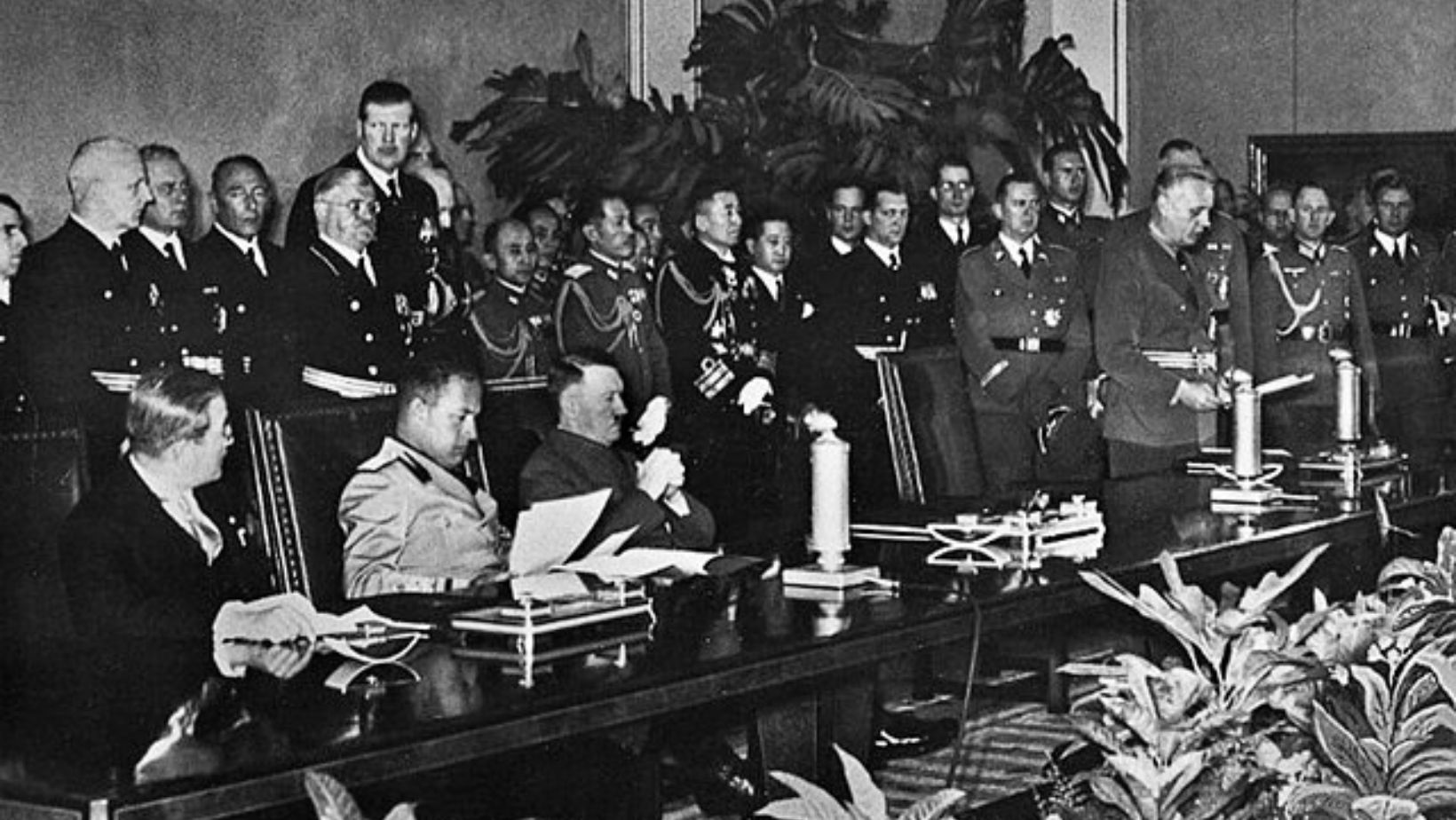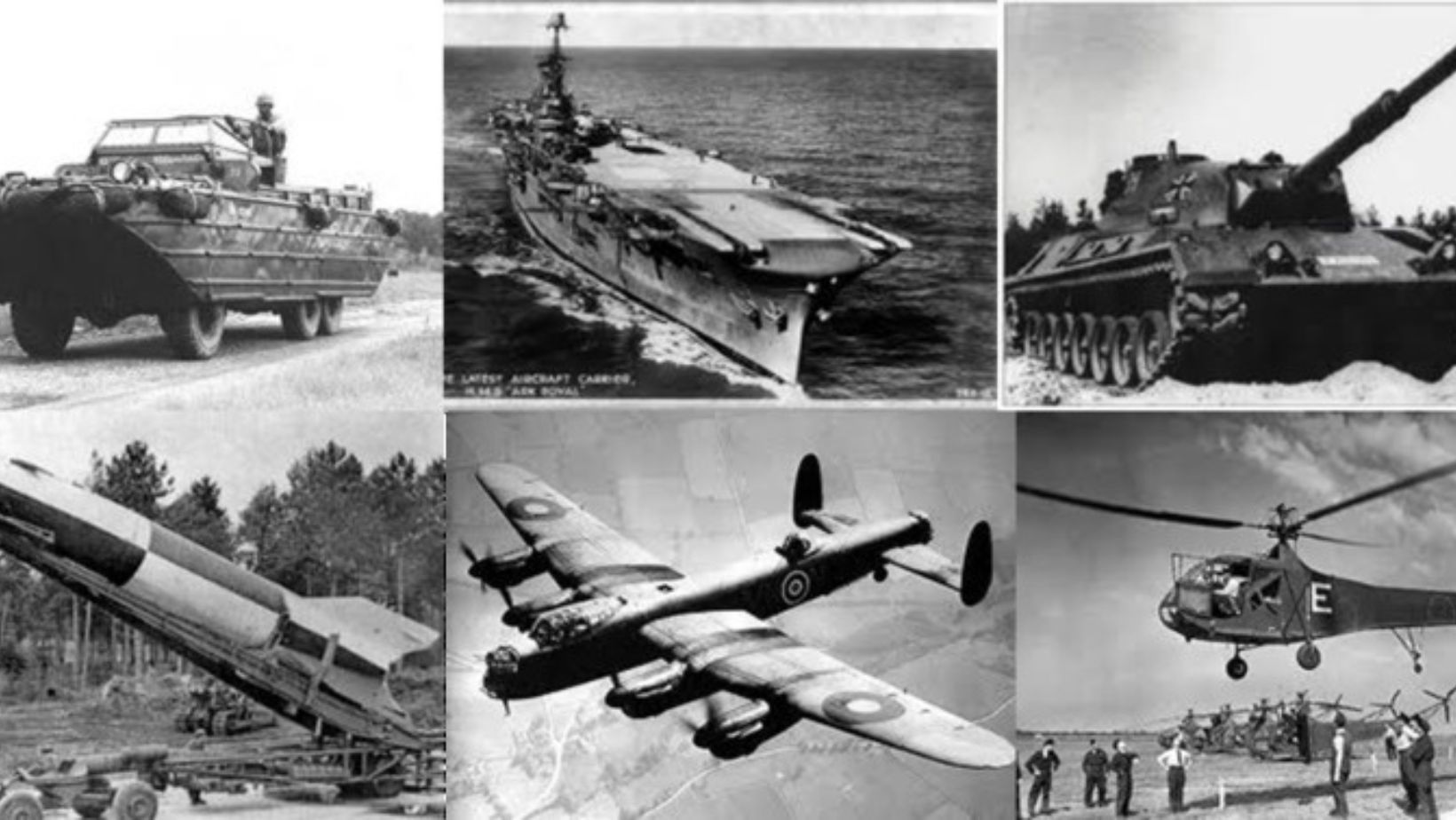World War II didn’t begin overnight; it was the result of decades of tension. The Treaty of Versailles, signed after World War I, left Germany humiliated and economically shattered. The harsh reparations imposed fueled resentment, making the rise of Adolf Hitler and the Nazi Party almost inevitable. Meanwhile, global economic instability, particularly the Great Depression, heightened feelings of desperation. As countries struggled to recover, militarism and expansionism took root, setting the stage for conflict. The world was on edge, waiting for the smallest spark to ignite what would become one of history’s deadliest wars.
The Axis Powers: Formation and Expansion

The Axis Powers were a military alliance formed in the 1930s, primarily made up of Germany, Italy, and Japan. These nations shared a common goal of territorial expansion and the desire to challenge the existing world order. Germany, under Adolf Hitler, sought to dominate Europe, while Italy, led by Benito Mussolini, aimed to revive the Roman Empire. Japan, under Emperor Hirohito, expanded its influence in East Asia and the Pacific.
The formation of the Axis was solidified by a series of agreements, including the Rome-Berlin Axis in 1936 and the Tripartite Pact in 1940, which formally included Japan. Early successes were evident as each nation quickly expanded its territories. Germany invaded Poland in 1939, starting World War II, and quickly overran much of Europe. Italy expanded into Ethiopia and later joined Germany in the invasion of France.
Japan, meanwhile, attacked China and later expanded into Southeast Asia and the Pacific islands. These early territorial gains marked a period of rapid expansion for the Axis Powers, which gained significant influence over vast regions. However, this success was short-lived as the Allies began to push back in the later years of the war.
The Allied Response: Unity in Crisis
During World War II, the major Allied nations— the United States, United Kingdom, Soviet Union, China, and France—united to confront the Axis powers. Each country brought unique strengths to the table. The United States provided industrial power and military resources, while the Soviet Union endured harsh battles on the Eastern Front. The United Kingdom offered strategic leadership and intelligence, and China contributed with its vast territory and resilience against Japan.
The formation of these alliances was based on shared goals: defeating the Axis and restoring global peace. Cooperation began early with the signing of agreements like the Atlantic Charter in 1941. Despite differences in political systems and goals, the Allies coordinated their efforts through regular summits and joint military operations. These included key decisions like the D-Day invasion and the strategic bombing campaign.
Effective communication and shared resources were essential to their success. The creation of the United Nations in 1945 was a direct result of their collaboration, aiming for long-term peace. Unity in the face of global crisis was vital, and these nations set aside their differences to focus on a common enemy, ensuring victory in the war.
The Battlefronts: Global Scope of the War
World War II was fought on multiple fronts, with each theater having a significant impact on the outcome of the conflict. In Europe, the Blitzkrieg strategy by Nazi Germany led to rapid conquests of much of Western Europe. Key battles like the Battle of Stalingrad and D-Day shaped the course of the war. These were turning points that eventually led to the collapse of Nazi forces.
In the Pacific, the war began with the surprise attack on Pearl Harbor by Japan in 1941. The United States then adopted an island-hopping strategy, aiming to capture key islands to get closer to Japan. Major battles like Midway and Iwo Jima were critical in weakening Japan’s defensive capabilities. The Pacific front saw intense naval and aerial combat.
The African and Middle Eastern theaters were also crucial. The Allied forces faced off against Axis powers in North Africa, with battles like El Alamein. The Middle East was strategically important for control over oil supplies. These theaters influenced the broader course of the war, affecting both logistics and morale.
The Holocaust: Humanity’s Darkest Hour
The Holocaust stands as one of the most horrific events in human history. Between 1941 and 1945, the Nazi regime systematically murdered six million Jews, along with millions of others, including Romani people, disabled individuals, and political dissidents. This genocide was driven by racist ideology, with Jews targeted for their religion and ethnicity. The Nazis implemented policies of mass deportation, forced labor, and extermination camps.
The horrors took place across Europe, with concentration camps like Auschwitz becoming infamous symbols of suffering. The Nazis used gas chambers, starvation, and medical experiments to torture and kill their victims. These crimes were not limited to Jews; millions of others were persecuted and murdered in the name of Nazi racial purity. The scale and cruelty of the Holocaust shocked the world and left lasting scars on humanity.
The Holocaust serves as a solemn reminder of the dangers of hatred, intolerance, and unchecked power. After World War II, the Nuremberg Trials were held to bring Nazi war criminals to justice. Today, the Holocaust is remembered through museums, education, and survivor testimonies, ensuring that such atrocities are never forgotten.
Turning Points: Key Battles and Moments
The Battle of Stalingrad, D-Day, and the Battle of Midway were pivotal moments in World War II. Each battle marked a dramatic shift in the war’s momentum toward the Allied forces. The Battle of Stalingrad (1942-1943) was a brutal confrontation between Nazi Germany and the Soviet Union. The German defeat crippled their eastern front, weakening their overall position.
D-Day (June 6, 1944) saw the Allied forces launch a massive invasion of Nazi-occupied France. The successful landing established a foothold in Western Europe, leading to the eventual defeat of Germany. This marked the beginning of the end for the Nazis.
The Battle of Midway (June 1942) was a decisive naval conflict between the United States and Japan. The U.S. Navy’s victory crippled Japan’s carrier fleet and shifted control of the Pacific to the Allies. These three battles played crucial roles in turning the tide of the war and setting the stage for the Axis powers’ eventual defeat.
The Role of Technology and Innovation

Advances in weaponry, tanks, planes, and nuclear technology have dramatically shaped modern warfare. Tanks revolutionized ground combat by providing mobility and protection to infantry. Meanwhile, airplanes changed aerial tactics, enabling bombing raids and reconnaissance missions. The development of nuclear technology introduced the potential for mass destruction, altering global military strategies.
Codebreaking and espionage played critical roles in gathering intelligence during conflicts. The ability to decipher enemy communications provided strategic advantages, as seen with the Allies’ breaking of the Enigma code during World War II. Espionage operations, such as undercover agents and surveillance, allowed nations to gather vital information while remaining undetected. These innovations not only affected battles but also influenced diplomacy and international relations.
The Home Front: The Civilian Experience
During wartime, civilians play a crucial role on the home front. Rationing became a common practice as governments limited resources like food, fuel, and clothing to support military needs. People were encouraged to make do with less, and families had to adjust to smaller portions and reduced supplies. Wartime sacrifices were a daily reality for many, but it helped to ensure the military received the necessary supplies.
War bonds were another way civilians contributed to the war effort. Citizens bought bonds to lend money to the government, which would be paid back with interest after the war. This helped fund military operations and strengthen the economy during difficult times. Many viewed purchasing bonds as a patriotic duty.
Women’s roles expanded during the war as they entered the workforce in greater numbers. With men away at the front, women took over jobs in factories, offices, and other sectors traditionally dominated by men. This shift not only supported the economy but also marked a turning point in gender roles, as women proved their capability in various fields.
Bombings on civilian areas were another harsh reality during wartime. Cities often faced airstrikes, causing widespread destruction and fear. The constant threat of bombings led to the development of air raid shelters and civil defense systems to protect families. These challenges deeply affected the daily lives of civilians during the war.
The War’s End: Victory and the Collapse of Axis Powers
The surrender of Germany and Japan marked the definitive end of World War II. In May 1945, Germany capitulated after Adolf Hitler’s death, leading to the fall of the Third Reich. The Allies celebrated VE Day (Victory in Europe), signaling the end of Nazi control. In August 1945, Japan’s surrender followed the dropping of atomic bombs on Hiroshima and Nagasaki, bringing the war to a close.
The Yalta and Potsdam conferences were key moments in shaping the post-war world. At Yalta, held in February 1945, leaders Winston Churchill, Franklin D. Roosevelt, and Joseph Stalin discussed the future of Europe. They agreed on the division of Germany into occupation zones and set the groundwork for the United Nations. However, tensions between the Soviet Union and the Western Allies were already rising.
The Potsdam Conference, held in July-August 1945, took place after Germany’s surrender. This time, President Harry Truman replaced Roosevelt, and Stalin was present again. The Allies issued an ultimatum to Japan, demanding unconditional surrender. The talks revealed deepening divisions, especially over the fate of Eastern Europe, setting the stage for the Cold War.
The Aftermath: A New World Order
After World War II, the global balance of power shifted dramatically. The United States and the Soviet Union emerged as the two dominant superpowers. Their contrasting ideologies, capitalism versus communism, set the stage for a new era of rivalry. This period marked the beginning of the Cold War, a geopolitical struggle that lasted for decades.
The formation of the United Nations in 1945 aimed to prevent future conflicts and promote global cooperation. It became a platform where nations could resolve disputes diplomatically, reducing the chance of war. Despite this, tensions between the U.S. and the Soviet Union grew, with both powers vying for influence around the world. The Cold War led to proxy wars, nuclear arms races, and intense political and military competition.
The rise of these superpowers and the establishment of international institutions like the UN reshaped the global order. It laid the foundation for the political dynamics of the 20th century. Nations aligned themselves with either the U.S. or the Soviet Union, deepening global divisions. The Cold War would ultimately define much of the world’s political landscape until the fall of the Soviet Union in 1991.
Rebuilding Nations: The Marshall Plan and Recovery
After World War II, Europe and Japan faced severe devastation. To help them recover, the United States introduced the Marshall Plan in 1948. This plan provided financial aid to rebuild European economies, restoring stability and preventing the spread of communism. The U.S. invested over $12 billion in Western Europe, which accelerated economic recovery.
In Japan, U.S. efforts focused on political and economic restructuring. The country received assistance to rebuild its industries and infrastructure. The occupation led by General Douglas MacArthur helped Japan transition from militarism to democracy. This support played a key role in Japan’s rapid economic growth.
International cooperation was crucial for the success of these efforts. The U.S. worked closely with European countries through organizations like the Organisation for European Economic Cooperation. This collaboration allowed for coordinated reconstruction and long-term growth. The shared goal was to create stable economies that could resist future conflicts.
The Marshall Plan and similar efforts were pivotal in shaping the post-war world order. They not only rebuilt economies but also fostered a sense of global unity. These efforts set the stage for the economic prosperity of the second half of the 20th century.
Legacy of World War II: Shaping the Modern World

World War II left profound effects on global politics, borders, and economies. The war led to the division of Europe, with Germany split into East and West, and the formation of new political entities like the United Nations. It reshaped power dynamics, with the U.S. and the Soviet Union emerging as superpowers, initiating the Cold War. This division created a lasting rivalry that shaped international relations for decades.
The economic impact of WWII was also significant. The war caused immense destruction but led to innovations in technology, trade, and industry. Post-war recovery efforts, such as the Marshall Plan, helped rebuild Europe and Japan, setting the stage for global economic cooperation. Additionally, the war influenced global trade policies and the development of new financial institutions like the International Monetary Fund.
Culturally, the war led to changes in society, especially in terms of gender roles and civil rights. Women’s contributions to the workforce during the war led to greater gender equality. WWII also sparked movements for decolonization, as former colonies sought independence. These shifts laid the groundwork for modern social movements.
Conclusion: World War II
In conclusion, World War II was a monumental event that reshaped nations, borders, and ideologies. The war caused immense loss of life and widespread devastation, but it also led to significant political and social changes. The war’s aftermath saw the rise of the United States and the Soviet Union as superpowers, the creation of the United Nations, and the beginning of the Cold War. The conflict also spurred advancements in technology, medicine, and international relations, laying the groundwork for the modern world. Understanding this period helps us appreciate the complexities of today’s global landscape.
FAQs
What were the main causes of World War II?
World War II was caused by a combination of factors, including the unresolved issues from World War I, the rise of fascist regimes in Europe, economic instability, and territorial ambitions by powers like Nazi Germany and Imperial Japan. The invasion of Poland by Germany in 1939 triggered the war.
How did World War II impact colonial empires?
World War II weakened many colonial empires, particularly European ones. The economic strain and the demands of wartime mobilization led to a loss of control over colonies, contributing to movements for independence in Asia, Africa, and the Middle East after the war.
What was the role of women during World War II?
Women played a crucial role in World War II, stepping into workforce roles that were previously reserved for men, such as factory work, military service in non-combat roles, and aiding with logistics and intelligence. This shift marked a significant change in gender roles and societal expectations.
How did World War II affect the global economy?
World War II caused massive economic disruption, but it also led to economic recovery in some nations, particularly the United States, which emerged as a global economic leader. The war effort boosted industrial production and led to technological advancements, while Europe and Japan struggled with post-war reconstruction.
What were the long-term effects of World War II on international relations?
The long-term effects of World War II reshaped international relations through the formation of the United Nations, aimed at preventing future global conflicts. The Cold War divided the world into two ideological blocs (the capitalist West and the communist East), leading to decades of tension, proxy wars, and competition for global influence.

